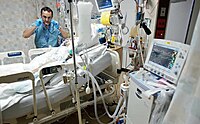
Photo from wikipedia
Background: The prevalence of malnutrition in emergency units is high, and data on the nutrition risk of patients admitted in these units are scarce. The aims of this study are… Click to show full abstract
Background: The prevalence of malnutrition in emergency units is high, and data on the nutrition risk of patients admitted in these units are scarce. The aims of this study are to determine the nutrition risk profile of individuals admitted in an emergency unit and to identify clinical, anthropometric, and laboratory attributes according to nutrition risk classification. Materials and Methods: A total of 234 individuals in an emergency unit from 1 university hospital in Brazil were enrolled in this cross-sectional study. The nutrition risk profile was determined using the Nutrition Risk Screening 2002. Sociodemographic, clinical, anthropometric, and laboratory data were collected. Comparisons between individuals “at risk” and “not at risk” and logistic regression analyzes were performed. Results: The prevalence of nutrition risk at admission was 48.7%. Patients at risk were older (P = .031), were less educated (P = .022), had a lower body mass index (P < .001), had higher concentrations of C-reactive protein (CRP; P = .007), had a higher CRP/serum albumin ratio (P = .004), had lower concentrations of serum albumin (P = .002), and had severe weight loss (P < .001). Altogether, this profile resulted in a longer hospital stay (P = .004), more complications (P = .005), and greater use of antibiotics (P = .024). In regression analyses, low serum albumin (odds ratio [OR], 2.75; 95% confidence interval [CI], 1.23–6.13) and, higher serum CRP (OR, 1.13; 95% CI, 1.00–3.72), use of antibiotics (OR, 13.3; 95% CI, 1.59–111.16) were predictors of long hospital stay. Conclusion: The prevalence of nutrition risk in emergency patients was high and its profile associated with worse clinical, laboratory, and anthropometric outcomes. The use of other laboratory and clinical variables may also be a good strategy for predicting adverse outcomes in emergency units.
Journal Title: Nutrition in Clinical Practice
Year Published: 2017
Link to full text (if available)
Share on Social Media: Sign Up to like & get
recommendations!